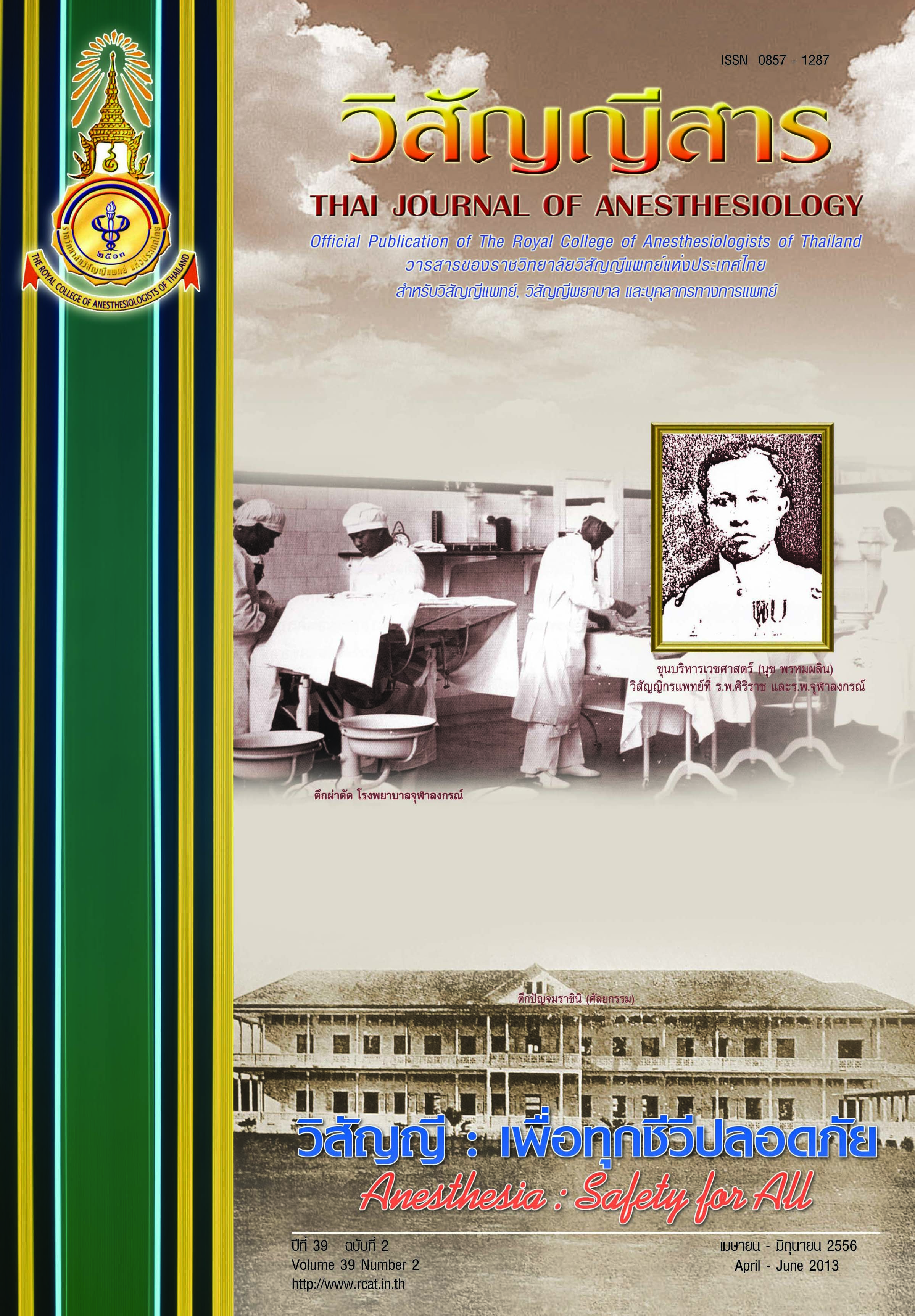Abnormal coagulation during open aortic surgeries analyzed by ROTEM: a pilot study in Thai patients
Main Article Content
Abstract
Background: A large amount of blood loss and blood transfusion are related to aortic surgeries under cardiopulmonary bypass machine (CPB). Causes of bleeding are partly from complicated coagulation abnormality. The usual monitor for coagulation might be ineffective.
Objectives: This study was aimed to reveal the patterns of coagulation abnormality after CPB that analyzed by thromboelastrogam (TEG) to detect the difference from the usual monitor.
Methods: Twenty patients, who were scheduled for aortic operations under CPB including ‘deep hypothermic circulatory arrest’ (DHCA) were recruited. Blood samples were drawn before the beginning of anesthesia, at 15 - minute after protamine - given, and at 45 - minute after protamine - given for analysis of activated clotting time (ACT) and TEG by ROTEM. Analysis of the ROTEM tests and the interpretations for application were based on the standard reference. ACT values were compared with the baseline ACT and the results of ROTEM.
Results: At 15 - minute after protamine was given, the abnormal coagulation that caused by both extrinsic and intrinsic factors was detected. At 45 - minute after protamine and some plasma transfusion were given, this abnormal coagulation was caused by intrinsic factors. In DHCA cases, the findings of abnormal coagulation at this point of time showed some heparin effects.
Conclusions: Different patterns of coagulation abnormality were revealed. Percentage changes in ACT values from the baselines might be helpful for decision-making in treatments where there is no TEG.
การวิเคราะห์ภาวะการแข็งตัวของเลือดผิดปกติด้วยเครื่อง ROTEM ในการผ่าตัดเส้นเลือดแดงเอออร์ต้า: การศึกษานำร่องในผู้ป่วยไทย
บทนำ: การผ่าตัดเส้นเลือดแดงเอออร์ต้าภายใต้การใช้เครื่องปอดและหัวใจเทียม เป็นการผ่าตัด ที่มีโอกาสเสียเลือดสูงและอาจมีความจำเป็นต้องให้สารประกอบเลือดในปริมาณมาก สาเหตุเลือดออกมัก เกิดจากภาวะแข็งตัวของเลือดผิดปกติที่ซับซ้อน การติดตามภาวะแข็งตัวของเลือดโดยปกติอาจไม่เพียงพอ
วัตถุประสงค์: ศึกษารูป แบบของภาวะแข็งตัวของเลือดผิดปกติภายหลังออกจากเครื่องปอดและหัวใจเทียมที่ วิเคราะห์โดย thrombolelastrogram (TEG) ว่าเป็นอย่างไรและมีความแตกต่างจากการติดตามโดยปกติอย่างไร
วิธีการศึกษา: ศึกษาในผู้ป่วยที่เข้ารับการผ่าตัดเลือดแดงเอออร์ต้าภายใต้การใช้เครื่องปอดและหัวใจเทียม ที่ โรงพยาบาลจุฬาลงกรณ์ จำนวน 20 ราย รวมการผ่าตัดที่ใช้เทคนิคหยุดระบบไหลเวียนที่อุณหภูมิต่ำ (DHCA) ติดตามภาวะแข็งตัวของเลือดผิดปกติด้วยค่า activated clotting time (ACT) และ TEG (ROTEM) โดยเก็บ ตัวอย่างเลือด 3 ครั้ง คือ ก่อนการระงับความรู้สึก ภายหลังให้โปรตามินหมด 15 นาที และภายหลังโปรตามิน หมด 45 นาที นำการทดสอบของ ROTEM มาวิเคราะห์และการแปลผลเพื่อประยุกต์ใช้ตามเกณฑ์อ้างอิง เปรียบเทียบการเปลี่ยนแปลงของค่า ACT ในช่วงต่าง ๆ เทียบกับค่า ACTแรกเริ่มและผลการวิเคราะห์จาก ROTEM
ผลการศึกษา: ในช่วงหลังให้โปรตามินหมด 15 นาทีพบความผิดปกติเกิดจากปัจจัยช่วยเลือดแข็งตัว ทั้งภายนอกและภายใน ในช่วง 45 นาทีหลังให้โปรตามินหมดและได้รับพลาสม่าจำนวนหนึ่งพบความผิดปกติ เกิดจากปัจจัยช่วยเลือดแข็งตัวเฉพาะภายใน ซึ่งหากมีการใช้เทคนิค DHCA ความผิดปกติช่วงนี้เกิดจาก ภาวะการกลับมาออกฤทธิ์ใหม่ของเฮพาริน
สรุป: พบปัญหาภาวะแข็งตัวของเลือดผิดปกติแตกต่างกันไปตาม ช่วงเวลา นอกจากนี้พบว่าร้อยละการเปลี่ยนแปลงของค่า ACT นำมาใช้ช่วยการตัดสินการรักษาได้ถึงแม้ไม่มี TEG


